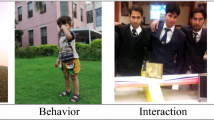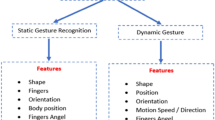Abstract
Hand gestures are a natural and intuitive form for human-environment interaction and can be used as an input alternative in human-computer interaction (HCI) to enhance usability and naturalness. Many existing approaches have employed vision -based systems to detect and recognize hand gestures. However, vision-based systems usually require users to move their hands within restricted space, where the optical device can capture the motion of hands. Also, vision-based systems may suffer from self-occlusion issues due to sophisticated finger movements. In this work, we use a sensor-based motion tracking system to capture 3D hand and finger motions. To detect and recognize hand gestures, we propose a novel angular-velocity method, which is directly applied to real-time 3D motion data streamed by the sensor-based system. Our approach is capable of recognizing both static and dynamic gestures in real-time. We assess the recognition accuracy and execution performance with two interactive applications that require gesture input to interact with the virtual environment. Our experimental results show high recognition accuracy, high execution performance, and high-levels of usability.






Similar content being viewed by others
References
Aigner R, Wigdor D, Benko H, Haller M, Lindbauer D, Ion A, Zhao S, Koh JTKV (2012) Understanding mid-air hand gestures: a study of human preferences in usage of gesture types for hci. Tech. rep. https://www.microsoft.com/en-us/research/publication/understanding-mid-air-hand-gestures-a-study-of-human-preferences-in-usage-of-gesture-types-for-hci/ https://www.microsoft.com/en-us/research/publication/understanding-mid-air-hand-gestures-a-study-of-human-preferences-in-usage-of-gesture-types-for-hci/
Alavi S, Arsenault D, Whitehead A (2016) Quaternion-based gesture recognition using wireless wearable motion capture sensors. Sensors 16 (5):605. https://doi.org/10.3390/s16050605
Bangor A, Kortum P, Miller J (2009) Determining what individual sus scores mean: adding an adjective rating scale. Journal of Usability Studies 4(3):114–123. https://uxpajournal.org/determining-what-individual-sus-scores-mean-adding-an-adjective-rating-scale
Brodie M, Walmsley A, Page W (2008) Fusion motion capture: a prototype system using inertial measurement units and gps for the biomechanical analysis of ski racing. Sports Technol 1(1):17–28. https://doi.org/10.1002/jst.6
Brooke J, et al. (1996) Sus-a quick and dirty usability scale. Usability Evaluation in Industry 189(194):4–7
Cassell J (1998) A framework for gesture generation and interpretation. Computer Vision in Human-Machine Interaction, pp 191–215
Cohen Y, Cohen JY (2008) Analysis of variance, in statistics and data with R: an applied approach through examples. Wiley, New York. https://doi.org/10.1002/9780470721896
Davis FD (1989) Perceived usefulness, perceived ease of use, and user acceptance of information technology. MIS Quarterly: 319–340
Diliberti N, Peng C, Kaufman C, Dong Y, Hansberger JT (2019) Real-time gesture recognition using 3d sensory data and a light convolutional neural network. In: Proceedings of the 27th ACM international conference on multimedia, MM ’19. https://doi.org/10.1145/3343031.3350958. ACM, New York, pp 401–410
Guna J, Jakus G, Pogačnik M, Tomažič S, Sodnik J (2014) An analysis of the precision and reliability of the leap motion sensor and its suitability for static and dynamic tracking. Sensors 14(2):3702. https://doi.org/10.3390/s140203702
Häger-Ross CK, Schieber MH (2000) Quantifying the independence of human finger movements: comparisons of digits, hands, and movement frequencies. J Neurosci Official J Society Neurosci 20(22): 8542–50
Hansberger JT, Peng C, Blakely V, Meacham S, Cao L, Diliberti N (2019) A multimodal interface for virtual information environments. In: Chen JY, Fragomeni G (eds) Virtual, augmented and mixed reality. Multimodal Interaction. Springer, Cham, pp 59–70
Hansberger JT, Peng C, Mathis SL, Areyur Shanthakumar V, Meacham SC, Cao L, Blakely VR (2017) Dispelling the gorilla arm syndrome: the viability of prolonged gesture interactions. Springer, Cham, pp 505–520. https://doi.org/10.1007/978-3-319-57987-0_41
Hauptmann AG (1989) Speech and gestures for graphic image manipulation. SIGCHI Bull 20(SI):241–245. https://doi.org/10.1145/67450.67496
Hummels C, Stappers PJ (1998) Meaningful gestures for human computer interaction: beyond hand postures. In: Third IEEE international conference on automatic face and gesture recognition, 1998. Proceedings. https://doi.org/10.1109/AFGR.1998.671012, pp 591–596
Hutchins EL, Hollan JD, Norman DA (1985) Direct manipulation interfaces. Hum-Comput Interact 1(4):311–338. https://doi.org/10.1207/s15327051hci0104_2
Kessler GD, Hodges LF, Walker N (1995) Evaluation of the cyberglove as a whole-hand input device. ACM Trans Comput-Hum Interact 2(4):263–283. https://doi.org/10.1145/212430.212431
Kieras D, Meyer D, Ballas J (2001) Towards demystification of direct manipulation: cognitive modeling charts the gulf of execution. In: Proceedings of the SIGCHI conference on human factors in computing systems, CHI ’01. https://doi.org/10.1145/365024.365069. ACM, New York, pp 128–135
Lang CE, Schieber MH (2004) Human finger independence: limitations due to passive mechanical coupling versus active neuromuscular control. J Neurophys 92 (5):2802–2810. https://doi.org/10.1152/jn.00480.2004
Lee J, Kunii TL (1995) Model-based analysis of hand posture. IEEE Comput Graphics Appl 15(5):77–86
Lin J, Wu Y, Huang TS (2000) Modeling the constraints of human hand motion. In: Proceedings of workshop on human motion. https://doi.org/10.1109/HUMO.2000.897381. IEEE, Austin, Texas, USA, pp 121–126
Liu K, Kehtarnavaz N (2016) Real-time robust vision-based hand gesture recognition using stereo images. J Real-Time Image Process 11(1):201–209. https://doi.org/10.1007/s11554-013-0333-6
Lu Z, Chen X, Li Q, Zhang X, Zhou P (2014) A hand gesture recognition framework and wearable gesture-based interaction prototype for mobile devices. IEEE Trans Human Mach Sys 44(2):293–299. https://doi.org/10.1109/THMS.2014.2302794
Luzhnica G, Simon J, Lex E, Pammer V (2016) A sliding window approach to natural hand gesture recognition using a custom data glove. In: 2016 IEEE symposium on 3D user interfaces (3DUI). IEEE, pp 81–90
Marin G, Dominio F, Zanuttigh P (2016) Hand gesture recognition with jointly calibrated leap motion and depth sensor. Multimed Tools Appl 75(22):14991–15015. https://doi.org/10.1007/s11042-015-2451-6
Morris MR, Wobbrock JO, Wilson AD (2010) Understanding users’ preferences for surface gestures. In: Proceedings of graphics interface 2010, GI ’10. http://dl.acm.org/citation.cfm?id=1839214.1839260. Canadian Information Processing Society, Ottawa, Ontario, Canada, pp 261–268
Neto P, Pereira D, Pires JN, Moreira AP (2013) Real-time and continuous hand gesture spotting: an approach based on artificial neural networks. In: 2013 IEEE international conference on robotics and automation. https://doi.org/10.1109/ICRA.2013.6630573, pp 178–183
Nielsen M, Störring M, Moeslund TB, Granum E (2003) A procedure for developing intuitive and ergonomic gesture interfaces for hci. In: International gesture workshop. Springer, pp 409–420
Pavlovic VI, Sharma R, Huang TS (1997) Visual interpretation of hand gestures for human-computer interaction: a review. IEEE Trans Pattern Anal Mach Intell 19 (7):677–695. https://doi.org/10.1109/34.598226
Peng C, Hansberger J, Shanthakumar VA, Meacham S, Blakley V, Cao L (2018) A case study of user experience on hand-gesture video games. In: 2018 IEEE games, entertainment, media conference (GEM). https://doi.org/10.1109/GEM.2018.8516520, pp 453–457
Peng C, Hansberger JT, Cao L, Shanthakumar VA (2017) Hand gesture controls for image categorization in immersive virtual environments. In: 2017 IEEE virtual reality (VR). https://doi.org/10.1109/VR.2017.7892311, pp 331–332
Ramamoorthy A, Vaswani N, Chaudhury S, Banerjee S (2003) Recognition of dynamic hand gestures. Pattern Recogn 36(9):2069–2081. https://doi.org/10.1016/S0031-3203(03)00042-6
Rautaray SS, Agrawal A (2015) Vision based hand gesture recognition for human computer interaction: a survey. Artificial Intelligence Review 43(1):1–54. https://doi.org/10.1007/s10462-012-9356-9
Rice M, Wan M, Foo MH, Ng J, Wai Z, Kwok J, Lee S, Teo L (2011) Evaluating gesture-based games with older adults on a large screen display. In: Proceedings of the 2011 ACM SIGGRAPH symposium on video games. ACM, pp 17–24
Sharma RP, Verma GK (2015) Human computer interaction using hand gesture. Procedia Comput Sci 54:721–727. https://doi.org/10.1016/j.procs.2015.06.085
Siek KA, Rogers Y, Connelly KH (2005) Fat finger worries: how older and younger users physically interact with pdas. In: IFIP conference on human-computer interaction. Springer, pp 267–280
Song Y, Demirdjian D, Davis R (2012) Continuous body and hand gesture recognition for natural human-computer interaction. ACM Trans Interact Intell Syst 2 (1):5:1–5:28. https://doi.org/10.1145/2133366.2133371
Venkatesh V, Davis FD (2000) A theoretical extension of the technology acceptance model: four longitudinal field studies. Management Sci 46(2):186–204
Vogel D, Casiez G (2012) Hand occlusion on a multi-touch tabletop. In: Proceedings of the SIGCHI conference on human factors in computing systems, CHI ’12. https://doi.org/10.1145/2207676.2208390. ACM, New York, pp 2307–2316
Wachs JP, Kölsch M, Stern H, Edan Y (2011) Vision-based hand-gesture applications. Commun ACM 54(2):60–71. https://doi.org/10.1145/1897816.1897838
Wang C, Liu Z, Chan SC (2015) Superpixel-based hand gesture recognition with kinect depth camera. IEEE Trans Multimed 17(1):29–39. https://doi.org/10.1109/TMM.2014.2374357
Wobbrock JO, Morris MR, Wilson AD (2009) User-defined gestures for surface computing. In: Proceedings of the SIGCHI conference on human factors in computing systems, CHI ’09. https://doi.org/10.1145/1518701.1518866. ACM, New York, pp 1083–1092
Xu D (2006) A neural network approach for hand gesture recognition in virtual reality driving training system of spg. In: 18th international conference on pattern recognition (ICPR’06). https://doi.org/10.1109/ICPR.2006.109, vol 3, pp 519–522
Acknowledgements
This work was supported by DOD grant W911NF-16-2-0016. We thank anonymous reviewers for their comments. We thank the people who participated in the user study.
Author information
Authors and Affiliations
Corresponding author
Additional information
Publisher’s note
Springer Nature remains neutral with regard to jurisdictional claims in published maps and institutional affiliations.
Rights and permissions
About this article
Cite this article
Shanthakumar, V.A., Peng, C., Hansberger, J. et al. Design and evaluation of a hand gesture recognition approach for real-time interactions. Multimed Tools Appl 79, 17707–17730 (2020). https://doi.org/10.1007/s11042-019-08520-1
Received:
Revised:
Accepted:
Published:
Issue Date:
DOI: https://doi.org/10.1007/s11042-019-08520-1




